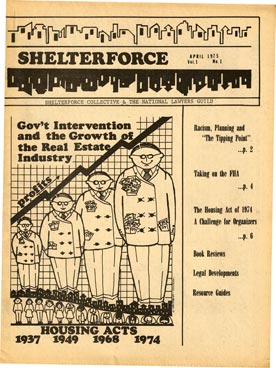In looking through the first four issues of Shelterforce from 1975-1976, flashes of myself, my work, and The Shelterforce Collective hit me. I remembered typing the articles in columns on typewriters and then using rubber cement to paste them down on our own layout boards. In that first year, we tried to be a collective – everybody working on every aspect of the newspaper. Nothing was more humorous then watching Ronnie Atlas trying to lay out “his page.” At one point he turned to me and said, “it’s impossible to lay out these columns straight, I can’t do it.” And he didn’t after that.
Our content was shaped by our belief that organizing, especially tenant organizing, was key to building a national movement. We saw Shelterforce as a vehicle for the development of strategies for tenants and housing activists across the country. Looking over the content and especially the articles I worked on in that first year – “Rent Strikers Withholding $25 Million;” “Fast Foreclosure: Abandoned Homes – Abandoned Dreams;” as well as the short articles in our regular feature, “Keeping The Heat On” (organizing stories from around the country) – I believe we provided our readers with some of the tools, contacts, information, and networking necessary for them to move forward in their local struggles.
[RELATED ARTICLE: The Rise and Fall of the National Tenants Union]
I worked on Shelterforce from 1975 through 1990. We changed from a newspaper to a magazine, from a tenants’ rights publication to a housing journal. The changes in format and content of Shelterforce reflected our own reformulations of what was needed to build the housing movement. Moving beyond solely tenant organizing, we filled the pages of Shelterforce with broader ideas of community-based housing, increased private capital, and local control.
And my strategies for social change have continued to evolve since leaving Shelterforce. From 1990 to 1992, I worked as the Senior Program Consultant for the National Congress for Community Economic Development (NCCED), the trade association of Community Development Corporations. From 1993 to 1995 I was the Vice President of the National Community Reinvestment Coalition (NCRC). In both positions, I learned first-hand about the failures and successes of working to revitalize and invigorate communities – both urban and rural – and the need to provide capital to build individual and community assets.
The road and the journey I started on 20 years ago is still in front of me. Shelterforce was that first road map, that first vehicle getting me to that first destination, that first organizing victory, that first home base. I hope Shelterforce serves its readers the same way it served me in my personal and political growth and understanding.



Comments